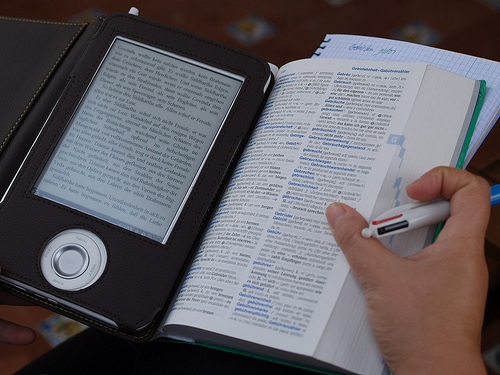Are printed textbooks about to go the way of the slide rule? The Obama administration is now officially nudging public schools to get digital textbooks in kids’ hands within five years, and has rolled out a “playbook” offering guidance.
Digital textbooks are widely viewed as a great way to save money and trees, provide interactive learning, and deliver up-to-date material more easily. And machine a sous a cinq rouleaux et 25 lignes de paiement, dont les paris vont d’une centime par ligne de mise a cinq dollars.html”>students love them because they lighten backpacks and increase go-anywhere convenience. (Here’s a cool infographic on why students want to jettison their textbooks.)
More and more schools are replacing textbooks with ebooks on laptops or tablets. But many schools lack the funding for broadband, let alone the computing platforms that ebooks require.
Digital textbooks are said to improve the learning process because they can be searchable, interactive and/or linked to other information sources, such as videos and web content. Digital textbook programs, like Macmillan’s DynamicBooks and others, let tutors and other educators customize ebooks by editing, annotating and even revising them. Syllabi, class notes, assignments and ancillary content can all be uploaded alongside a text. That means more freedom to teach.
It also potentially means greater accessibility and learning value for special needs kids, since the digital platform is more amenable to changes like larger text or text-to-speech.
But will pairing video clips and web access with ebooks only make the learning environment more distracting? It seems logical that printed books support focused reading better than tablet devices, if only because print is easier on the eyes. But distractions abound, however the assignment is delivered…
And are digital textbooks really cheaper? Used hardback books are pretty cheap. Renting textbooks on a Kindle is often the cheapest digital option. Most digital textbooks remain comparatively expensive. Some schools are from the publisher, which saves everybody money. But while Kindles have come way down in price, iPads sure aren’t inexpensive yet.
Then there are the many books, such as those with colored plates, which simply can’t be replaced by ebooks. (I can vouch for this: I love the convenience of field guides on my iPhone for birds, flowers and trees – but they’re no substitute for the “real thing.”) And while printed books might be less portable than ebooks, they’re also less likely to have technical problems or run out of batteries.
Another challenge that many students point out about ebooks is that they’re not ideal for note-taking or sharing. (Digital rights management (DRM) restrictions can make it darn hard to share an ebook.)
Perhaps this is why a recent survey by library ebook provider eBrary showed that students’ use of digital textbooks hasn’t increased all that much in the past three years. Many students also still find the “shopping experience” for printed books to be easier – especially since many books are not yet available in digital form. Usage restrictions and a lack of cool features – including markup/note-taking and especially integration with social media sites for “social reading” purposes — also are hindering student adoption of ebooks.
As students’ needs are better understood and addressed by digital content providers, the adoption of ebooks will undoubtedly increase. The students, after all, are the ones who need to study. They will choose the best learning tools they can get for their money.
Are you seeing increased use of digital textbooks in your school or tutoring practice?
Featured image courtesy of teclasorg.
SAT vs ACT: Choosing the Right Test [NEW EBOOK]
Download this free 20-Page Ebook for Tutors Now!
Our free 20-page ebook is a step-by-step guide on how to select the right test for your student. Learn everything you need to know about using the PLAN and PSAT to improve student scores, how to leverage learning analytics to select one test over the other, and other tips on how to take the guesswork out of selecting the ACT vs the SAT.












Even though their are easy to carry around they cannot give the convenience of a actual text book.
Yes, of course I have seen more than 50%
students use of digital textbooks in my college. I think it is very easy to use
and comfortable to carry.
A paper textbook is exactly the same as a digital textbook (e-book) with the exception of the material it’s presented in. The digital textbook allows you to carry and have on hand, in one gadget, at least a hundred books whereas you’d only be able to carry at most 10 of these in paper format. Digital textbooks may not be necessarily better; they are certainly more efficient and (because of the weight) healthier.
That said, learning shouldn’t be limited to reading the books, whether they be print or digital. Schools – and teachers – should not remove the aspect of discussion and interaction between teacher and student, student and student. Learning cannot be done thru memorization alone; you learn when you question and explore. The amount of knowledge that lies around us is boundless and the more we learn, the more everything becomes more exciting.